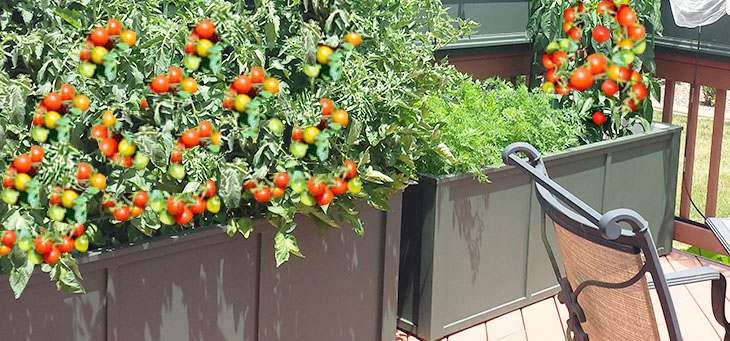How To Grow Tomatoes In Outdoor Planters
Here are helpful hints to ensure you grow the best tomatoes that are delicious and free of pesticides.
Select The Correct Planter
The first step in planting tomatoes in outdoor planters is selecting the correct container. Look for a container at least 18 inches in diameter and 24 inches deep to provide enough space for the tomato plant to grow. You can use traditional pots, raised beds, hanging baskets, or square planters for growing tomatoes outdoors. Because tomatoes require a lot of planting space it is important to consider your budget and location to determine how many pots or planters you want to use for your garden. Creating a garden on your deck can be a convenient way to grow tomatoes.
Select The Right Tomato Variety
The second step is to select a suitable tomato variety for your container. Consider the size of the container and the amount of sunlight the plant will receive when choosing a variety. Dwarf or determinate tomato varieties are best suited for smaller containers, while indeterminate varieties will require larger containers and support structures.
As the tomato plant grows, it will require support to keep it upright and prevent it from falling over. Use stakes or a trellis to support the plant, and tie the stems to the support as needed. Regular fertilization will provide your tomato plants in containers or outdoor planters with the necessary nutrients for growth and fruit production. Use a balanced fertilizer high in phosphorus to promote fruit production, and follow the instructions on the package for the best results.
Tomato Growth Stages
The tomato is a nutritious vegetable with vitamins, minerals, antioxidants, and phytochemicals. The tomato plant grows from seedlings to fully mature plants over about 3 to 4 months. Each stage depends on the plant varieties, temperature, sunlight and soil conditions, and nutrients. You can enjoy tomatoes raw or cooked and used in several recipes.
Five Growth Stages of Tomatoes
· Germination and early growth, with the formation of the first leaves (between 25 – 30 days)
· Seedling period, 20 – 25 days
· Vegetative, 20 – 30 days
· Flowering 20 – 30 days
· Mature fruiting, 15 – 20 days
A tomato plant typically takes 80 days to mature. Planting seeds at the beginning of August will yield results by mid-September. However, if you plant seeds at the end of August, they'll be ready to harvest by the beginning of October.
Germination And Early Growth Stage Of Tomato
To ensure tomato seedlings germinate, they require warmth, moisture, and oxygen. Soil temperatures must be between 70 – 85 Degrees F (21,11 – 26,67 degrees Celsius). Under these conditions, plant growth is assured. For tomato plants to germinate, they also require proper soil conditions. A tomato plant requires soil with the correct temperatures. Avoid soil that is too hot or cold.
You may plant tomato seeds into a container or outdoor planter where you control the soil, water, and temperature requirements. Alternatively, you may grow them directly in the ground but ensure that you sow the seeds in a shallow groove. Tomato plants also require space, so you should spread them out evenly in your outdoor planter once they germinate. In this way, you give the plants more growth space and ensure sufficient oxygen for the plants.
Seedling Stage Of Tomato
Once the seeds germinate, you notice cotyledons (seed leaves) and hypocotyl (the stem below the cotyledon) will appear. This begins the vegetative stage and lasts between two to four weeks. Tomato plants are small and fragile at this stage, and gardeners should handle them carefully. They also require more sunlight; approximately six hours per day is sufficient for their growth.
Soil conditions should not be too dry or too moist. This will cause the plants to wilt and die, or the excess water may cause root rot, which may also kill your delicate plants. Planter water reservoir systems can be used for larger planters to help keep the soil from drying out. A deep self-watering planter box can help keep soil moist but not too moist.
Feeding your seedlings with an appropriate fertilizer is essential to ensure healthy plants. If you consider using a liquid fertilizer, mix the following ratios, N – P – K (nitrogen, phosphorous, and potassium), in equal portions of 10 – 10 – 10 or 20 – 20 – 20. You may also use granulated fertilizer, but you must follow the instructions carefully. Granulated fertilizer allows for a slow release of nutrients, which may be suitable for tomato plants. As a young plant, one of the things you need to watch out for is bugs and insects. Getting rid of these pests is easy if you use pesticides or remove the infected parts of the plant. Taking action immediately when spotted ensures a healthy tomato plant.
Vegetative Stage Of Tomato
Your little tomato seedling is growing! During the third or vegetative stage, the tomato plant grows taller, producing more new leaves. You notice the stems thicken, and flowers will begin to appear. This phase lasts between four to six weeks. The plant begins to grow larger and develop its structure. You notice the leaves also get more prominent with the cotyledon-infused color pattern. I call it the "teenage years," when the plant requires more sunlight, food, and water to ensure proper growth.
The plant roots grow and reach deeper into the ground. If you are thinking of transplanting the seedling into other containers or outdoor planters, this is the time. At the vegetative stage, tomato plants require sufficient sunlight, water, and nutrients to reach their potential size and ensure a bountiful produce yield. Therefore give those seedlings some extra care and attention.
Flowering Stage Of Tomato
The fourth stage, referred to as the flowering phase, is not actually about the flowers but rather about the beginning stages of the fruit. The entire phase from flower to fruit lasts between six to eight weeks. But the actual flower stage lasts for two weeks. And during this time, the tomato plant requires ample sunlight, water, and nutrients. As mentioned previously, tomato plants need approximately six hours of sunlight a day to flower. Therefore it is wise to grow tomatoes in outdoor planters or containers so you can move them around for maximum sunlight. You must adjust the watering and fertilizer requirements if you do not notice flowers after the requisite time.
At this stage, you also need to keep an eye out for flowers that have not budded into fruit. In this way, you direct the plants' energy resources to fruit that has the potential to flourish. The flowering stage is crucial to ensure a healthy plant and yield a good crop in the long term. Therefore keep insects and bugs away from the budding fruit and flowers.
Mature Fruiting Stage Of Tomato
Your little tomato is all grown up! You may shed a little tear at how far this tender plant has come. In the final stage, the mature fruit phase, you may prepare for the removal of these precious fruits from the vines. The tomatoes will be decadent red or orange, which signifies the fruits are ready for picking. However, some may harvest tomatoes when they are not entirely red but with a slight greenish tinge.
Large-scale farmers may choose to harvest tomatoes by hand or machine. Growing tomatoes in containers or outdoor planters allow you to pick them directly from the vines. Whichever picking method you choose, these tender fruit still needs to be picked with some care to prevent damage to the delicate skins. Once picked, you can store them on your kitchen counter to ripen.
Days To Maturity Of Tomato
The days to maturity refer to the time from seedling to mature fruit. The time depends on the fruit variety, for not all tomato varieties mature simultaneously. Listed below is a guide to days of maturity for different varieties.
1. Early Season Tomato Varieties
Early-season tomato varieties such as Anna Russian, Cherry Grande, Cherry Pink, or Cupid require 50 to 60 days to mature.
2. Mid-Season Tomato Varieties
Mid-season varieties such as Abraham Lincoln, Alisa Craig, Atkinson, and Ball's Beefsteak require 60 to 80 days to reach maturity.
3. Late Season Tomato Varieties
Tomatoes such as Amana orange, Brandywine, and Cherokee purple are late-season varieties. These varieties mature within 80 days.
Conclusion
This article gives you a better idea for growing different varieties of tomatoes in your outdoor planter or suitable container. The article will help determine when to expect your tomato plants to start flowering, fruit set, and ripening. So, you're always aware of the lifespan of your tomato plant. The next time someone asks you, "When will my tomatoes start to flower?" you'll be ready with the answer. Flower Window Boxes, Inc. is an online
window box and planter company specializing in custom flower boxes.
 About the Author About the Author
Matthew Buquoi is the owner of Flower Window Boxes, Inc., which is one of the largest online flower box companies in the United States. In addition to being the owner, he is also an expert author, and regularly writes about industry topics in the window boxes, planters, exterior shutters, and home and garden industry.
|
|
|